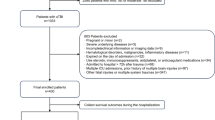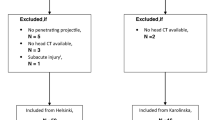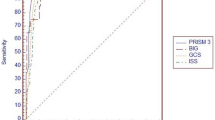Abstract
Objective
The GCS-Pupils (GCS-P) score is a recently described scoring system to aid outcome prediction in patients with traumatic brain injury (TBI). The aim of this study was to provide the first external validation of the GCS-P score by identifying independent predictors of outcome in TBI patients.
Methods
Review of prospective adult (≥ 16 years) TBI database at a tertiary neurosurgical center with a catchment population of 1.5 million over a 12-month period commencing October 2016. Multivariate logistic regression was used to identify predictors of discharge destination and 30-day mortality.
Results
Three hundred and fifty-eight patients were included. The median age was 60 years with a male predominance of 64%. The median GCS-P was 14 (interquartile range 12–15) and the commonest GCS-P category was mild (13–15; 238/358, 66%). Discharge destination was home in 69% of patients and rehab services or equivalent in 31%. Multivariate analysis identified age (p = 0.01), CT findings of an acute subdural hematoma (p = 0.01) or diffuse axonal injury (p = 0.02), and a neurosurgical operation (p = 0.02) as independent predictors of discharge destination. The 30-day mortality rate was 11%. Within the category of severe TBI (GCS-P ≤ 8), GCS-P was able to identify patients with a very high likelihood of 30-day mortality (GCS-P ≤ 4; 16/31, 52%). Multivariate analysis revealed the Charlson comorbidity score (p = 0.01), GCS-P (p = 0.02), and traumatic subarachnoid hemorrhage (p = 0.05) as independent predictors of mortality.
Conclusion
The GCS-P is a useful predictor of 30-day mortality, although its usefulness for other clinical outcomes remains to be proven.


Similar content being viewed by others
References
Balestreri M, Czosnyka M, Chatfield Da, Steiner La, Schmidt Ea, Smielewski P, Matta B, Pickard JD (2004) Predictive value of Glasgow Coma Scale after brain trauma: change in trend over the past ten years. J Neurol Neurosurg Psychiatry 75(1):161–162
Baucher G, Troude L, Pauly V, Bernard F, Zieleskiewicz L, Roche PH (2019) Predictive factors of poor prognosis after surgical management of traumatic acute subdural hematomas: a single-center series. World Neurosurg 126:e944–e952
Brennan PM, Murray GD, Teasdale GM (2018) Simplifying the use of prognostic information in traumatic brain injury. Part 1: The GCS-Pupils score: an extended index of clinical severity. J Neurosurg 128(6):1612–1620
Chestnut RM, Ghajar J, Maas AIR, Marion DW, Servadei F, Teasdale G, Unterberg A, Von Holst H, Walters BC (2000) Part 2: early indicators of prognosis in severe traumatic brain injury. J Neurotrauma 17(6–7):555–627
Eisenberg HM, Gary HEJ, Aldrich EF, Saydjari C, Turner B, Foulkes MA, Jane JA, Marmarou A, Marshall LF, Young HF (1990) Initial CT findings in 753 patients with severe head injury. A report from the NIH Traumatic Coma Data Bank. J Neurosurg 73(5):688–698
Fearnside MR, Cook RJ, McDougall P, McNeil RJ (1993) The Westmead Head Injury Project outcome in severe head injury. A comparative analysis of pre-hospital, clinical and CT variables. Br J Neurosurg 7(3):267–279
Fuller G, Bouamra O, Woodford M et al (2011) Temporal trends in head injury outcomes from 2003 to 2009 in England and Wales. Br J Neurosurg 25(3):414–421
Greene KA, Marciano FF, Johnson BA, Jacobowitz R, Spetzler RF, Harrington TR (1995) Impact of traumatic subarachnoid hemorrhage on outcome in nonpenetrating head injury. Part I: A proposed computerized tomography grading scale. J Neurosurg 83(3):445–452
Hamidi M, Zeeshan M, Leon-Risemberg V, Nikolich-Zugich J, Hanna K, Kulvatunyou N, Saljuqi AT, Fain M, Joseph B (2019) Frailty as a prognostic factor for the critically ill older adult trauma patients. Am J Surg 218(3):484–489
Kehoe A, Rennie S, Smith JE (2014) Glasgow Coma Scale is unreliable for the prediction of severe head injury in elderly trauma patients. Emerg Med J 32(8):613–615
Lee SY, Kim SS, Kim CH, Park SW, Park JH, Yeo M (2012) Prediction of outcome after traumatic brain injury using clinical and neuroimaging variables. J Clin Neurol 8(3):224–229
Teasdale G, Maas A, Lecky F, Manley G, Stocchetti N, Murray G (2014) The Glasgow Coma Scale at 40 years: Standing the test of time. Lancet Neurol 13(8):844–854
Utomo WK, Gabbe BJ, Simpson PM, Cameron PA (2009) Predictors of in-hospital mortality and 6-month functional outcomes in older adults after moderate to severe traumatic brain injury. Injury 40(9):973–977
Wardlaw JM, Easton VJ, Statham P (2002) Which CT features help predict outcome after head injury? J Neurol Neurosurg Psychiatry 72(2):188–92 (discussion 151)
Wijdicks EFM, Bamlet WR, Maramattom BV, Manno EM, McClelland RL (2005) Validation of a new coma scale: the FOUR score. Ann Neurol 58(4):585–593
Author information
Authors and Affiliations
Corresponding author
Ethics declarations
Ethical approval
All procedures performed in studies involving human participants were in accordance with the ethical standards of the institutional and/or national research committee and with the 1964 Helsinki declaration and its later amendments or comparable ethical standards. For this type of study, formal consent is not required.
Competing interests
The authors declare no competing interests.
Additional information
Publisher's note
Springer Nature remains neutral with regard to jurisdictional claims in published maps and institutional affiliations.
This article is part of the Topical Collection on Brain trauma
Previous Presentations: Poster Presentation at SBNS, Virtual Meeting, UK April 2021
Rights and permissions
Springer Nature or its licensor (e.g. a society or other partner) holds exclusive rights to this article under a publishing agreement with the author(s) or other rightsholder(s); author self-archiving of the accepted manuscript version of this article is solely governed by the terms of such publishing agreement and applicable law.
About this article
Cite this article
Maye, H., Waqar, M., Colombo, F. et al. External validation of the GCS-Pupils Score as an outcome predictor after traumatic brain injury in adults: a single-center experience. Acta Neurochir 165, 289–297 (2023). https://doi.org/10.1007/s00701-022-05431-3
Received:
Accepted:
Published:
Issue Date:
DOI: https://doi.org/10.1007/s00701-022-05431-3




